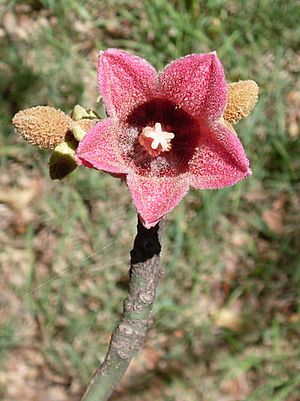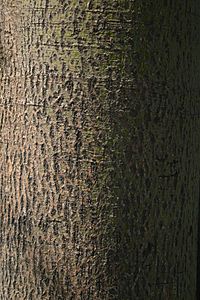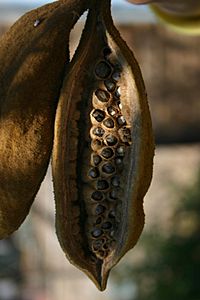Brachychiton discolor facts for kids
Quick facts for kids Brachychiton discolor |
|
|---|---|
 |
|
| Lacebark tree at the Royal Botanic Gardens, Sydney | |
| Scientific classification | |
| Genus: |
Brachychiton
|
| Species: |
discolor
|
| Synonyms | |
|
|
The Brachychiton discolor is a beautiful tree found in the rainforests of eastern Australia. It often grows in parts of the rainforest that are a bit drier. You can find these trees spread out from Paterson, New South Wales in the south to Mackay, Queensland in the north. There's even a small group of them far north in the Cape York Peninsula. This tree has also been known to grow in southern California.
People call this tree by many names. Some common ones are lacebark tree, lace kurrajong, pink kurrajong, scrub bottle tree, white kurrajong, hat tree, and sycamore.
Contents
What Does It Look Like?
This is a very attractive tree that can grow quite tall. It can reach up to 30 metres (about 100 feet) high. It has lovely pink flowers that don't have petals.
Trunk and Leaves
The trunk of the lacebark tree is straight and grey. It's shaped like a cylinder and can be as wide as 75 centimetres (about 30 inches). The base of the trunk does not have large, wide supports. Its young branches are hairy, brown, and smooth.
The leaves are also hairy. They usually have three, five, or seven points, like fingers. Each leaf can be 10 to 20 centimetres (4 to 8 inches) wide. The top side of the leaf is dark green, while the underside is whitish. You can easily see the veins on both sides of the leaves.
Flowers and Fruit
The flowers of the lacebark tree bloom from November to February. They are pink and grow very close to the branch, almost without stalks. Each flower is about 3 to 4 centimetres (1 to 1.5 inches) wide. Interestingly, the male and female flowers grow separately on the tree and do not have petals.
After the flowers, the tree produces a special fruit. This fruit is a hairy, boat-shaped pod called a follicle. These pods ripen between December and July. They can be quite long, from 7 to 20 centimetres (3 to 8 inches). Inside each pod, there can be up to 30 seeds, each about 9 millimetres (0.35 inches) long. It's quite easy to grow new trees from fresh seeds.
How People Use It
The lacebark tree is very popular for planting in gardens and parks. People love it because it's so beautiful.
Traditional Uses
Long ago, Indigenous Australians used the wood from this tree to make shields. These shields were important tools.
Edible Seeds
The seeds of the lacebark tree can be roasted and eaten by people. They are a source of food.
See also
 In Spanish: Brachychiton discolor para niños
In Spanish: Brachychiton discolor para niños



